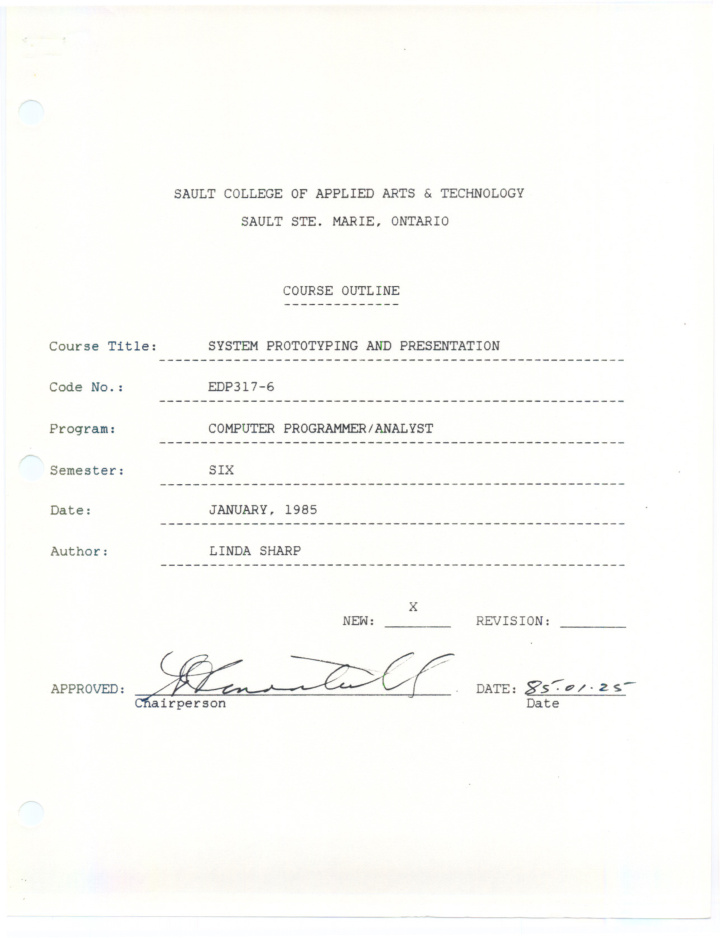



SAULT COLLEGE OF APPLIED ARTS & TECHNOLOGY SAULT STE. MARIE, ONTARIO COURSE OUTLINE -------------- Course Title: SYSTEM PROTOTYPING AND PRESENTATION -------------------------------------------------------- Code No.: EDP3l7-6 -------------------------------------------------------- COMPUTER PROGRAMMER/ANALYST Program: -------------------------------------------------------- SIX Semester: -------------------------------------------------------- Date: JANUARY, 1985 -------------------------------------------------------- Author: LINDA SHARP -------------------------------------------------------- X NEW: REVISION: :FS": APPROVED: DATE: t? /. Z. s- Date - - - -
- 2 - ------------------------------------------------------------------------------ SYSTEM PROTOTYPING & PRESENTATION EDP317- ------------------------------------------------------------------------------ EDUCATIONAL GOALS ----------------- This course is designed to: prepare the future professional programmer/analyst for their role in the analysis and design of information systems; continue the study of system development started in EDP3l6, SYSTEM DESIGN AND PRESENTATION, emphasizing Prototyping as an effective enhancement to the analysis process; give the student a working knowledge of a 4th generation language. OVERVIEW -------- PROTOTYPING is USER-INVOLVED system development, an enhancement to the traditional system development process. Operational, working systems are created virtually on a real-time basis. That is, a transition is made directly from user requests to computerized implementation of a system that complies with this request. This is done with powerful application software development tools that make it possible to create all of the files and processing programs needed for a business application in a matter of days, perhaps even hours. A PROTOTYPE is, in fact, a working system. It can be developed quickly and inexpensively - given the necessarysoftwaretools. Prototypesare built iteratively. Basic requirements are identified and implemented quickly~ Then, the prototype is used, requirements are modified, and the process is repeated. The result may serve as the primary statement of new system requirements in the analysis and general design phase of the system development life cycle, or it may be accepted as the new system itself. This course consists of two one hour lectures and two two hour labs. In the lectures, a prototyping case study for an online information system is followed from start to finish. In the labs, a 4th generation language (data management system) is investigate and used to develop prototypes. The language used is POWERHOUSE. The study begins with a low level walkthru of the tool, using the PRIMER and then the features of POWERHOUSE are investigatedin more depth and ends with the development and presentation of working prototypes. -- - -----
- 3 - ------------------------------------------------------------------------------- SYSTEM PROTOTYFING & PRESENTATION EDP3l7-1 ------------------------------------------------------------------------------. STUDENT RESPONSIBILITIES AND EVALUATIONCRITERIA ------------------------------------------------ You must have Assignments and required reading fully completed before clas to fully benefit from and participate in discussions and mini-presentations. There will be quizzes throughout the semester with little or no warning based on the specific learning objectives attached. There will be two or three tests through the term, depending on the schedule, each lasting two hours. ~~~ The semester schedule is tentative and may change to meet student needs ~~ A SESSION is a I-hour lecture or a 2-hour lab. 16 sessions are accounted for on topic schedule allowing time for assignments and tests as there are 24 sessions in the semester (12 weeks/2 sessions per week). STUDENT EVALUATION STUDENT GRADING ------------------ --------------- 50% A 85 -100 Tests & Quizzes 75 - 84 20% B Assignments 60 - 74 Presentations 20% C 10% o - 59 R Participation TEXTBOOK AND MATERIALS ---------------------- SYSTEM ANALYSIS AND DESIGN A Structured Approach William S. Davis Addison Wesley HOW TO DEVELOP BUSINESS APPLICATIONS WITH POWERHOUSE for VAX/VMS - Cognos A PowerHouse Primer Dictionary - Reference Card - Cognos PowerHouse Card - Cognos - PowerHouse Quick Reference Manuals - available for reference in Work Room PowerHouse - -- - -
- 4 - ------------------------------------------------------------------------------ SYSTEM PROTOTYPING & PRESENTATION EDP3l7-. ------------------------------------------------------------------------------ SEMESTER LECTURE SCHEDULE ------------------------------------------------------------------------------ SESSION REFERENCE TOPIC ------------------------------------------------------------------------------ 1 Course Outline, Admin. 2 Overview Chapter 1 Structured Systems Analysis & Design - AN ONLINE CASE STUDY C SYSTEM 3 Problem Definition Chapter 14 4 Chapter 15 The Feasibility Study 5 U II U II II 6 Chapter 16 Analysis 7 .. II It II 8 Chapter 17 System Design 9 PERT and CPM .. .. plus Module L 10 Summary 11 Chapter 18 Detailed Design 12 II .. plus Modul'e M - File Design & Space Estimates 13 .. .. Forms & Reports plus Module N - 14 Chapter 19 Implementation 15 II .. Maintenance 16 Summary ------------------------------------------------------------------------------ SEMESTER LAB SCHEDULE ------------------------------------------------------------------------------ SESSION REFERENCE TOPIC ------------------------------------------------------------------------------ 1 Primer Introduction to the Dictionary II II 2 to QUICK " II 3 U II II "to QUIZ 4 Manuals More QUIZ SORT statements SELECT, CHOOSE statement 5 Multi-File Access 6 producing reports element formatting PAGE HEADING, PAGE FOOTING statements 7 Temporary items Define statement & date data defining string, numeric, 8 Manuals to QTP Introduction 9 REQUEST, ACCESS, & OUTPUT statements 10 SELECT, & SUB FILE ITEM, statements EDIT & SORT statements 11 adding, updating, deleting 12 EDIT statement (LOOKUP options) ITEM statements (INITIAL, FINAL, SUBTOTAL options) 13 OUTPUT statement (IF, VIA, USING options) 14 More on QUICK 15 SCREEN, FILE, TITLE, GNERATE, BUILD statements 16 How to use Q DESIGN & QUICK -
Recommend
More recommend